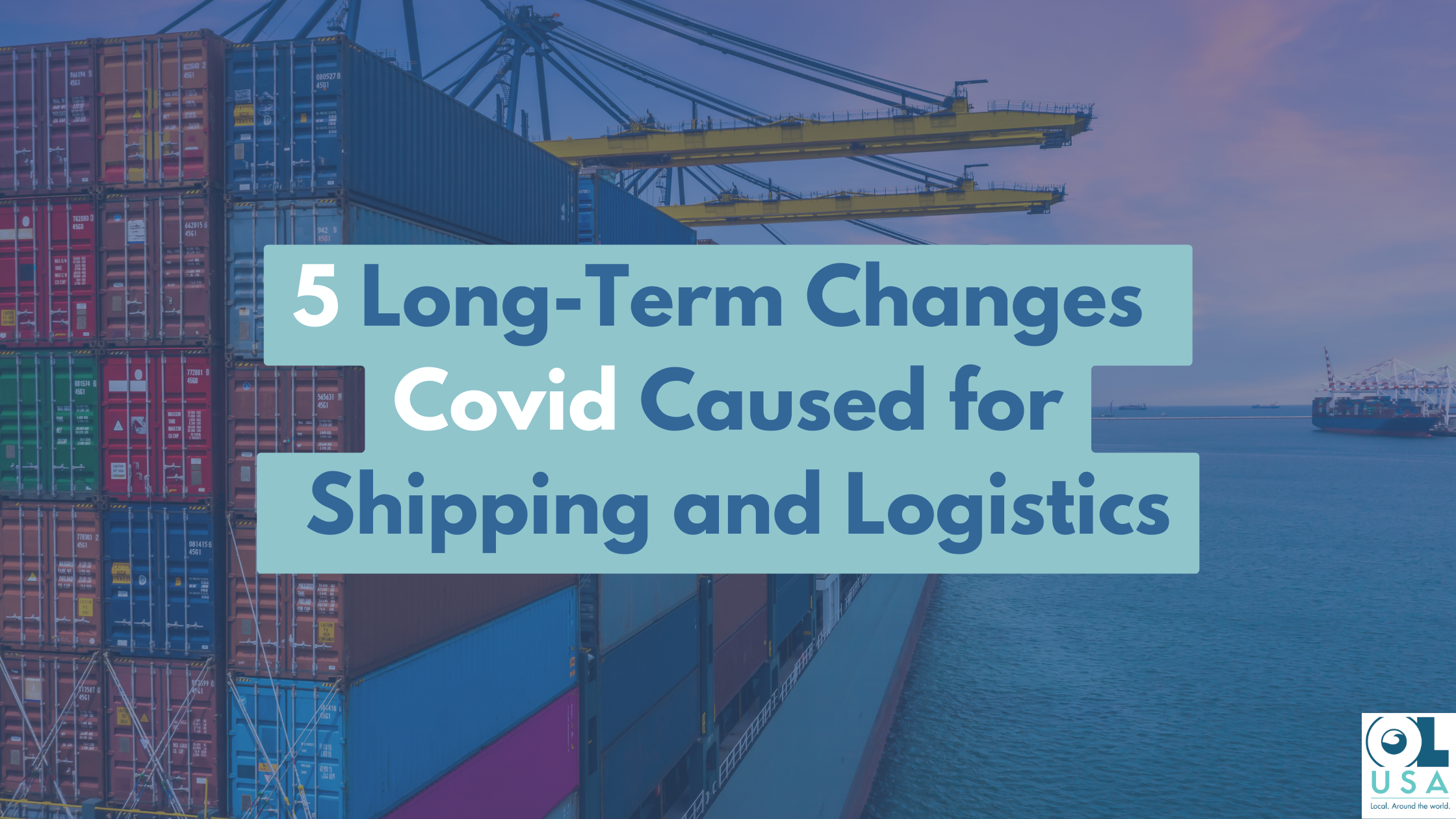Remember back in March and April of 2020 when nobody could find toilet paper? That was the first nationwide supply chain crisis most of the United States can remember since the Gas Shortage from the seventies. Slowly, over the past couple of years, we’ve started to “get back to normal,” though we’re not quite there yet—and, to be blunt, “normal” heading into the future is going to look less like “normal” from 2018 than most of us hope. Some of the changes made to shipping and logistics processes in response to Covid will be felt for a long time—and they might be permanent. Here are some we think will stick around for years to come.
1. Companies are prepared to spend more to keep their doors open
The earliest days of Covid were tough for just about everybody—it was notoriously difficult for those in the service industry, but retailers were also severely impacted. The first wave of Covid shortages happened during the first few days—the famous Toilet Paper Mania, alongside the Hand Sanitizer Drought. While some of us can look back and shake our heads at how absurd it seems now, the fact remains that people were scared. The fear that gripped most of the population drove them to stockpile the types of supplies they thought they’d need to stay put for weeks at a time—and there was a lot of conflicting information in many US state governments, too. Which businesses were “essential?” Which were going to stay open, and which were going to be closed? The rampant uncertainty and fear triggered an inventory shortage like we haven’t seen in decades in the United States.
The biggest impact was dramatic for many smaller retailers. While the biggest corporations—Wal-Mart, Walgreens, Stop & Shop, etc.—had enough resources to weather the inventory crunch due to almost astoundingly well vertically integrated supply chains, smaller retailers did not. They were used to dealing with a variety of wholesalers and transportation businesses to get what they needed, but suddenly that wasn’t enough. They found themselves faced with only a few tough options: tighten their belts, shut down, or sacrifice margin.
What we’ve seen is that the businesses who narrowed their profit margins to acquire the inventory they needed are, by and large, the ones who are still standing today.
This isn’t only true for the smaller retailers, either. Many of the massive brands went in the opposite direction from their traditionally effective practices. Most businesses have spent the past several decades laser-focused on cutting costs and increasing productivity to maximize their returns. Wal-Mart, for example, had infamously granular inventory management processes. But in the inventory and shipping crunch that started in 2020 and still, in some cases, continues today, they slowed down that granularity and instead began stocking up.
The simple truth is that nobody knew what was coming next. Would there be a Coca-Cola shortage? Better stock up, just in case. Same with Adidas sneakers. And paper towels. And motor oil. And, and, and… In short: businesses started stockpiling rather than relying on smaller, just-in-time shipments. And there’s no sign that that’s going to stop anytime soon. Nobody knows what’s just around the corner, and uncertainty is best countered with caution.
2. “Supply Chain” is finally getting the attention it’s always needed
If you look back at news articles from, say, 1990 through 2020, you won’t find many using the term “supply chain.” Executives didn’t have all that much visibility into what went on within their supply chain, either—for them, it was just shipping and delivery. What could possibly be so complicated about that?
It turns out, it’s extremely complicated. That won’t be news to those of us in this industry, but it seems like it was to executives in other industries.
Supply chain visibility became murkier and murkier to high-level executives as the world economy became more and more globalized. When you’re dealing with production and procurement that’s spread across dozens of countries, it became extremely difficult to closely monitor each stage individually. Instead, they tended to have a more general, higher-level view of their overall supply chain, because it wasn’t thought to be all that practical to keep a close eye on the dozens, hundreds, or thousands of moving parts.
A small bright spot from the Covid pandemic is that businesses have changed that attitude. Executives have learned that hard lesson over the past two and a half years, and are investing heavily into their own supply chains—and their level of visibility. They’re building or acquiring software to help automate and track these massive cogs in the machine, naturally, but they’re also partnering with logistics organizations who have the best insight and real information to work with.
3. Inventory practices have changed forever
It used to be all about “buy only what you need when you need it,” because businesses got used to hitting a button and getting rapid delivery—and their customers got used to it, too. Now, manufacturers and retailers are stocking up in advance, making sure they’re ready for the next shortage or slowdown. That’s a big adjustment for most industries, and some businesses who attempted to make this change early on made some crucial missteps.
The initial panic-buying in the early days of the pandemic gave some businesses the wrong idea, and they overstocked. That’s not quite the same thing as stocking up, though the difference can be hard to spot. Lots of businesses watched their inventory shrink during the early days of the pandemic (around March and April of 2020) and started rapidly refilling it as quickly as possible. Some were able to secure advantageous financing options open to many businesses. For those who took them, these low-interest funding options took some of the pressure off, which helped many of them focus on meeting customer demands without cutting payroll. That worked out for them for a few quarters. Furniture, sporting goods, building materials, exercise equipment, camping and RV suppliers—many of these suppliers filled up their warehouses to meet the increased demand.
Unfortunately, the increased demand that continued through much of 2021 began to drop off in early 2022. Few anticipated the length and severity of the lockdowns—and how deeply it has impacted the market. But many continued their overordering, and are now left with full warehouses and fewer people to sell their products to.
This is impacting the old playbook for shipping product across the world. Shipping space went through a tremendous crunch, but it’s gradually improved over the past year or so, and rates are plummeting as a result. That’s had a huge impact on carriers and logistics providers, as they’ve had to anticipate significant rate swings during this upheaval. Probably the most enduring impact from Covid is that noticeable changes in these processes are becoming more common, in both directions, and that can be tough to deal with in day-to-day business. Ideally, you should work with a partner who has a network of resources to help get you what you need at a price you can handle.
4. Bigger networks are more resilient
We know bigger isn’t always better, but numbers do matter. Before Covid, most businesses worked with a relative few shipping partners to get their products and materials. Maintaining a handful of relationships was much simpler than the alternative. But, once again, Covid shone a spotlight on that practice, which was adapted in the name of “efficiency.” Slowdowns and shortages pointed out the weakness in that approach. Now, organizations are working with much bigger networks, because the businesses with redundancy suffered far fewer problems than the ones who didn’t.
It’s a simple approach to what amounts to a pretty simple pitfall. The more partners you can get into business with, the likelier it is that you’ll be able to get what you need when you need it—and yes, it really is that straightforward.
The problem with this approach is the opposite of the efficiency argument in favor of fewer partnerships: managing relationships is time-consuming, not to mention distracting. Most businesses don’t have the time or labor available to keep a close eye on dozens or hundreds of shipping partners, especially when other costs are rising rapidly. That’s where logistics providers can make a tremendous difference. It’s much more cost-effective to work with one partner who will handle the relationships with a wide network of other partners for you. You work with a single point of contact, and let them worry about managing the rest of it.
5. Environmental changes
Green initiatives aren’t going away—in fact, there are a rising number of environmental mandates and regulations every year. Nations across the world have decided that the market changes sparked by Covid is a chance for them to guide industry down a more environmentally friendly path forward. While the biggest focus of these initiatives is always going to be on energy production, that alone has significant impacts across a huge swath of other industries, including—you guessed it—shipping and logistics.
Even assuming direct regulations will apply only to energy, that has a follow-up effect across basically every other industry sector. Everybody needs energy, and the more regulations apply to energy, the more the price will be impacted. The price of fuel alone is going to affect shipping costs, which can shave away more margin from sellers at a time when they’re already shaving margin to stay open. There is tremendous uncertainty about energy costs even a year from today, but most will agree on one point: it will be higher than it is now. The only real question is how much higher. Unless there’s another energy revolution, fuel costs are going to increase. The environmental initiatives—though they may help save nature—are going to speed up these increases, no matter how you slice it. You need to plan ahead.
Though there are some other methods you might use to help defray increased shipping costs over the next few years, they’re all time-consuming or expensive in one way or another. It is far simpler and efficient to work with a partner who can find you the best rates with the most reliable carriers. Shipping and logistics providers are a huge force multiplier when it comes to this process, because they have access to a wide network of global shipping partners to work with, and a big part of their value is finding the best rates for their customers Covid has certainly changed the way business operates around the globe, and shipping and logistics in particular. The worldwide upheaval has shown us where our biggest weaknesses are, so now businesses are getting creative to overcome them. OL-USA has helped countless businesses during the Covid pandemic and beyond. We understand these problems, and, more importantly, we have the experience and resources necessary to help you solve them. Don’t wait for the next crisis—plan ahead. Reach out to us, and we’ll consult with you, find out your goals, then build a comprehensive solution that addresses your specific needs.



